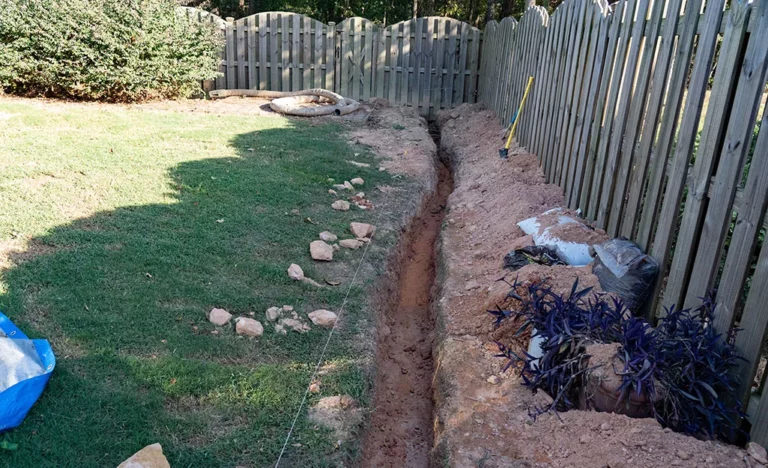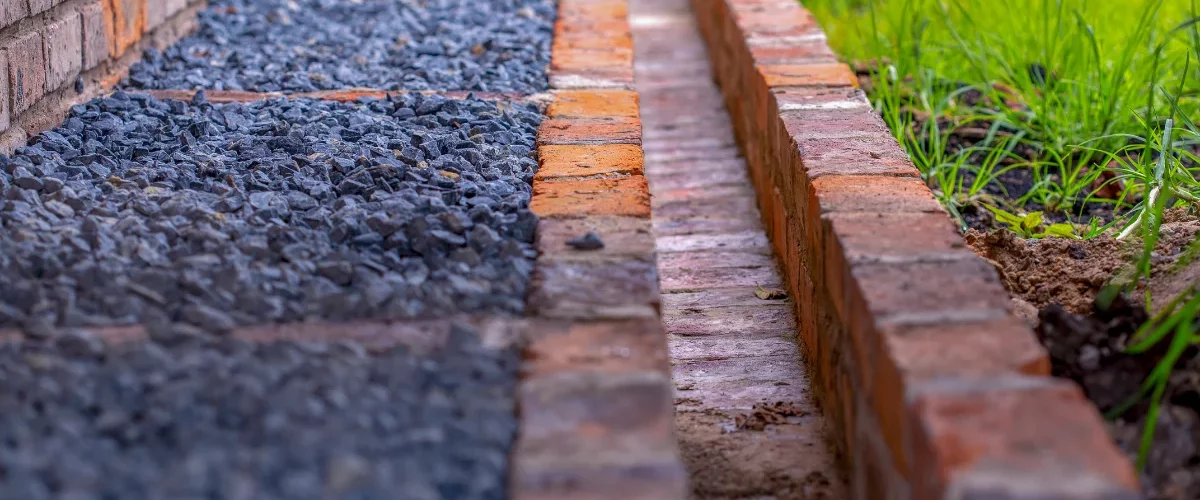Ever catch yourself watching a tiny pond pop up in your backyard every time it pours? Yep, it gets to all of us. Battling bad drainage feels like a losing match with Mother Nature. But hold up, don’t let that soggy mess get you down. The trick isn’t to fight the water but to get smarty-pants about guiding it away from your pad. Our tricks for keeping your place dry are just what you need. We’re diving into easy peasy methods like putting in French drains or whipping up rain gardens that soak up that extra water like magic. Plus, we’ll let you in on the simple fix of stretching those downspouts further to stop your home’s base from getting drenched and dodging expensive fixes. And guess what? These fixes are not only super effective; they’re buddies with the Earth too! Stick with us. By the time we’re through, you’ll be wowed.
Understanding Drainage Issues and Their Impact on Your Home
If you’ve noticed puddles in your lawn or pools of water on the driveway, you might be facing a drainage problem. Water stains in the basement are another sign that your home has a water drainage issue.
Poor drainage can cause serious damage to various parts of your house. The foundation may develop cracks due to excess moisture. This leads not only to structural instability but also paves way for mold growth, especially within interior walls. Yuck!
Your sidewalks, driveways, and retaining walls aren’t immune either. They could all bear the brunt of poor water management around your property. So if these signs sound familiar – don’t ignore them.
The folks at Garland Landscape in Gig Harbor offer expert advice and services tailored specifically for tackling common drainage issues effectively.
Simple Solutions for Yard Drainage
Your yard is more than just a green space; it’s your home’s first line of defense against water damage. A soggy yard or pooling water near the foundation can lead to costly damage, including mold growth and basement flooding. Here’s a couple of ideas to drain water away from your house and out of your yard.
Cleaning Gutters Regularly
Maintaining clean gutters is essential in preventing clogging and eventual flooding. Remember this rule of thumb: out of sight should not mean out of mind. By simply removing leaves, twigs, or any debris that could obstruct water flow, you ensure smooth sailing – literally. We suggest doing these deep cleans about twice a year.
Extending Downspouts Away from Home
Next up: extending downspouts. Redirecting rainwater at least 6 feet away from your home gives surface water a ticket out of trouble town, protecting your beloved abode from unwanted moisture and potential foundation damage. Talk about a lifesaver.
Installing French Drains for Effective Water Drainage
If you’re dealing with a soggy yard or basement flooding, installing a French drain could be your path to dry land. This drainage solution efficiently redirects water away from problem areas in your yard and home.
A French drain is a trench filled with gravel that directs water away from the house. The landscape fabric lining prevents soil from clogging up the system while allowing excess surface and subsurface water to flow freely into it.
This single point of collection then carries the water downhill by gravity’s pull, effectively reducing potential foundation damage or flooded basements at home. But remember – installation requires moving soil and adding dirt strategically; so if you need help, don’t hesitate to ask professionals.

Creating a Rain Garden to Divert Water Away from Your Home
Rain gardens are not just advantageous to the environment, but also an effective method of redirecting water away from your residence. They help collect and filter runoff water, preventing soggy yards and potential foundation damage.
Building one is like creating a living sponge in your yard. You start by choosing a spot where water collects or near downspouts. Dig about 6 feet deep, then line it with landscape fabric.
Add layers of sand, soil bed, compost, and native plants that love wet environments. These elements work together as they absorb excess surface water while adding aesthetic appeal to your landscape. Rain gardens are one of our favorite ideas to drain water away from your house and aim it towards something good.

This green solution redirects running water efficiently while reducing the risk of costly basement flooding or mold growth caused by poor drainage solutions. Genius, right?
Utilizing Rain Barrels for Water Collection and Drainage
Picture this: It’s pouring rain outside, but instead of watching all that water go to waste, you’re collecting it in a rain barrel. A simple yet powerful tool to manage your home drainage while saving on your water bills.
Benefits of Using Rain Barrels
A rain barrel not only stores excess runoff, it also reduces demand on the local water supply. Imagine cutting down up to 1,300 gallons during peak summer months. Plus, plants love natural rainfall more than treated tap water.
Rain barrels can also help with yard drainage issues by collecting roof runoff which would otherwise lead to soggy lawns or even basement flooding. So why not install one today? You’ll be making an eco-friendly choice and keep your wallet happy too.

Read on for more ideas to drain water away from your house.
Implementing Landscape Changes for Better Drainage
Changing the landscape around your house can greatly improve drainage. Techniques like sloping the ground away from your home and using clay-like soil can help sculpt a more effective drainage system.
Garland Landscape’s landscaping contractors can help make your new landscape dream a reality, while offering professional solutions and ideas to drain water away from your house.
The Importance of Proper Grading
Maintaining proper grading in your yard is crucial to prevent water pooling near your home’s foundation. A slope that directs water away from the house, rather than towards it, works wonders. For instance, The Spruce suggests maintaining a gradient of 1 inch per foot for optimal results.
Another method you could use involves changing up the type of soil around your property’s perimeter. Clay soils have higher compaction and are less likely to let water seep into them as quickly as sandy or loamy soils would do.
Sculpting with Soil
To manage surface water effectively, start by moving soil strategically around where you notice damage due to excess moisture such as mold growth on interior walls or even structural integrity issues due to heavy rain.
If these methods don’t seem sufficient enough for where you live—say if it rains often—you might need additional reinforcements like installing French drains which collect surface runoff and redirect it elsewhere before it gets too close to damaging structures.
In Need of Drainage Solution?
It’s clear that tackling drainage issues is no small feat. But with the right approach, you can turn your soggy yard into a water-efficient paradise.
The ideas to drain water away from your house shared here range from simple to slightly more complex. Yet all aim at achieving one thing: guiding excess water where it needs to go, not where it wants to go.
Cleaning gutters regularly and extending downspouts play vital roles in directing rainwater safely away from your home’s foundation. French drains work wonders in managing both surface and subsurface water around the house.
Rain gardens are an eco-friendly solution that absorb runoff while adding aesthetic appeal. And don’t forget about using rain barrels for saving precious resources!
If problems persist or seem overwhelming, landscaping pros from Garland Landscape is just a call away.
FAQs in Relation to Ideas to Drain Water Away From Your House
How do I divert water runoff away from my house?
You can use French drains, extend downspouts, rain barrels, or create a rain garden to guide water away from your home.
What is the best material to drain water away from the house?
Crushed stone and gravel are great for promoting drainage. They’re commonly used in constructing French drains.
How do you pipe water away from your house?
Piping is done using underground pipes connected to gutters or sump pumps, directing water safely off property.
How do I direct downspout water away from my house?
Add extensions onto your downspouts. Aim for at least 6 feet of distance between discharge point and foundation.

